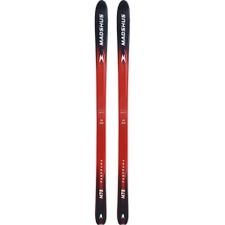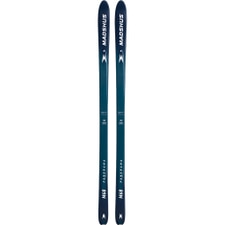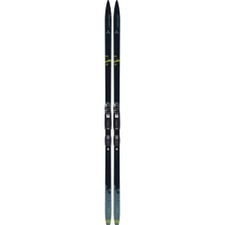Backcountry skis

- - 11 %
 FischerAdventure 62 Crown Xtralite + Control Step-In 23/24 Classic No-Wax Ski Set (Ski + Binding)MSRP 269,95 €239,95 €Available Sizes:169179189199
FischerAdventure 62 Crown Xtralite + Control Step-In 23/24 Classic No-Wax Ski Set (Ski + Binding)MSRP 269,95 €239,95 €Available Sizes:169179189199 - - 14 %
 FischerSpider 62 Crown Xtralite + Control Step-In 23/24 Classic No-Wax Ski Set (Ski + Binding)MSRP 349,95 €299,95 €Available Sizes:169189199
FischerSpider 62 Crown Xtralite + Control Step-In 23/24 Classic No-Wax Ski Set (Ski + Binding)MSRP 349,95 €299,95 €Available Sizes:169189199 - - 31 %
 MadshusPanorama M78 23/24 Backcountry Ski Red - BlackMSRP 389,95 €269,00 €Available Sizes:162
MadshusPanorama M78 23/24 Backcountry Ski Red - BlackMSRP 389,95 €269,00 €Available Sizes:162 - - 33 %
 MadshusPanorama M68 23/24 Backcountry Ski GreenMSRP 369,95 €249,00 €Available Sizes:172182192
MadshusPanorama M68 23/24 Backcountry Ski GreenMSRP 369,95 €249,00 €Available Sizes:172182192 - - 25 %
 FischerOutback 68 Crown/Skin Xtralite 23/24 Backcountry SkiMSRP 329,95 €249,00 €Available Sizes:169189199
FischerOutback 68 Crown/Skin Xtralite 23/24 Backcountry SkiMSRP 329,95 €249,00 €Available Sizes:169189199 - - 32 %
 MadshusPanorama M62 23/24 Backcountry Ski Blue - BlackMSRP 349,95 €239,00 €Available Sizes:162172182192202
MadshusPanorama M62 23/24 Backcountry Ski Blue - BlackMSRP 349,95 €239,00 €Available Sizes:162172182192202 - - 21 %
 FischerS-Bound 98 Crown/Dual-Skin Xtralite 23/24 Backcountry SkiMSRP 439,95 €349,00 €Available Sizes:169179189
FischerS-Bound 98 Crown/Dual-Skin Xtralite 23/24 Backcountry SkiMSRP 439,95 €349,00 €Available Sizes:169179189 - - 12 %
 RossignolBC 65 Positrack 23/24 Backcountry Ski 000MSRP 249,95 €219,95 €Available Sizes:165195
RossignolBC 65 Positrack 23/24 Backcountry Ski 000MSRP 249,95 €219,95 €Available Sizes:165195 - - 19 %
 FischerTraverse 78 Crown/Skin Xtralite 23/24 Backcountry SkiMSRP 369,95 €299,00 €Available Sizes:169179189199
FischerTraverse 78 Crown/Skin Xtralite 23/24 Backcountry SkiMSRP 369,95 €299,00 €Available Sizes:169179189199 - - 12 %
 RossignolBC 80 Positrack 23/24 Backcountry Ski 000MSRP 339,95 €299,95 €Available Sizes:186
RossignolBC 80 Positrack 23/24 Backcountry Ski 000MSRP 339,95 €299,95 €Available Sizes:186 - - 25 %
 FischerTransnordic 66 Crown Xtralite 23/24 Backcountry SkiMSRP 329,95 €249,00 €Available Sizes:185190
FischerTransnordic 66 Crown Xtralite 23/24 Backcountry SkiMSRP 329,95 €249,00 €Available Sizes:185190 - - 20 %
 FischerTransnordic 66 Crown/Skin Xtralite 23/24 Backcountry SkiMSRP 409,95 €329,00 €Available Sizes:185
FischerTransnordic 66 Crown/Skin Xtralite 23/24 Backcountry SkiMSRP 409,95 €329,00 €Available Sizes:185 - - 38 %
 MadshusPanorama SF 62 23/24 Backcountry Ski DesignMSRP 289,95 €179,00 €Available Sizes:182192
MadshusPanorama SF 62 23/24 Backcountry Ski DesignMSRP 289,95 €179,00 €Available Sizes:182192
- - 70 %
 MadshusPanorama M68 Intelligrip Transition Skin Set 20/21 Backcountry SkiMSRP 399,95 €119,95 €Available Sizes:165
MadshusPanorama M68 Intelligrip Transition Skin Set 20/21 Backcountry SkiMSRP 399,95 €119,95 €Available Sizes:165 - - 34 %
 FischerTransnordic 82 Easy Skin Xtralite 22/23 Backcountry SkiMSRP 379,90 €249,00 €Available Sizes:186196
FischerTransnordic 82 Easy Skin Xtralite 22/23 Backcountry SkiMSRP 379,90 €249,00 €Available Sizes:186196 - - 28 %
 FischerTransnordic 66 Easy Skin Xtralite 22/23 Backcountry SkiMSRP 344,90 €249,00 €Available Sizes:185
FischerTransnordic 66 Easy Skin Xtralite 22/23 Backcountry SkiMSRP 344,90 €249,00 €Available Sizes:185 - - 17 %
 FischerTransnordic 59 Easy Skin Xtralite 22/23 Backcountry SkiMSRP 299,90 €249,00 €Available Sizes:180195205210
FischerTransnordic 59 Easy Skin Xtralite 22/23 Backcountry SkiMSRP 299,90 €249,00 €Available Sizes:180195205210 - - 12 %
 FischerCountry Crown 60 23/24 Backcountry SkiMSRP 169,95 €149,95 €Available Sizes:185
FischerCountry Crown 60 23/24 Backcountry SkiMSRP 169,95 €149,95 €Available Sizes:185



Snow-covered untouched valleys, endless wide plains and forests – you are looking for the peace and beauty of exactly those places that are least frequented in the winter time? Then you've come to the right place in the backcountry cross-country skiing category! With this category guide, we'll explain everything you need to know about backcountry skiing away from prepared slopes.
So what is backcountry cross-country skiing?
First of all, sorry to all our readers from the Northern Hemisphere! You know for sure what is meant by backcountry cross-country skiing. These opening lines are, of course, aimed at all newcomers!
If we tear back in time a bit, the origins of almost all ski disciplines can be found in the daily motion with skis. Where skis still serve as a means of mobility and subsistence in some parts of the world, in other places they are high-performance recreational sports equipment. Backcountry skiing takes up exactly here and stands for exploring and moving in places which seem impassable due to the snow situation in winter.
Due to their width, backcountry skis offer significantly more float in deep snow than classic or skating skis. In addition, these skis have steel edges, which in combination with skins or scales serve for safe traversing in steep terrain. Skins and scales? That's right! Depending on the model and manufacturer, backcountry skis, like classic cross-country skis, have a gliding zone as well as a climbing zone. Skins, scales or climbing waxes provide grip, generating friction against the direction of travel when in contact with the snow.
Backcountry boots are designed for the corresponding middle widths and weight ratios of the skis, significantly more durable compared to normal cross-country ski boots. The shaft is reinforced and ensures better power transmission to the skis. In addition, backcountry cross-country ski boots have thick insulation and are designed for long multi-day expeditions.

Skin, fish scales or wax skis?
Whether for long distances, technical climbs and descents or fast running sessions, the biggest differences between backcountry skis are found in the base.
In the range of skin skis, there are two types of skis. Skis with a continuous glide zone on which a climbing skin can be optionally mounted, as with touring skis. Another type of ski has an integrated climbing skin that serves as a permanent climbing zone.
Backcountry skis with a continuous glide zone are more similar to touring or alpine skis than classic cross-country skis, due to their center width, edges and cuts. These skis are perfect for steep, technical ascents and longer telemark-style descents. Models with permanent skins, on the other hand, offer easy progression without stop-and-go before or after ascents or descents.
Backcoutry fish scaled skis have scale-like fins in the climbing zone that create friction when in contact with the snow. The advantage over fell skis is lower gliding resistance and maintenance in the climbing zone. However, compared to fur skis, scaled skis have poorer climbing properties. Therefore, scaled skis are suitable for terrain with moderate gradients.
The climbing zone on wax skis can consist of a klister or climbing wax coating, or combinations of both. This special surface provides grip and progress on the climb. Since these skis require significantly more maintenance, there are almost no pure wax skis left in our partners' product range. Alternatively, there are skis to choose from that use the Fischer EasySkin or Madshus Intelligrip system, for example. These skis have a receptacle for skins, which can alternatively be quickly clamped onto the climbing zone, depending on the condition.

Backcountry bindings
From 44 to 86 millimeters center width, the right binding ensures optimal power transmission, control and safety. In our range we distinguish between three different types of backcountry bindings, which can be used depending on the mounting options of the skis.
75 mm are 3-pin based bindings, which have a clamping mechanism on the front binding plate. The matching 75 mm boots have an extended sole that engages and locks into this mechanism like a bridge with three slots. In addition to guiding, the bar provides the appropriate flex so that glide and climb phases can be initiated. Depending on the binding model, there are versions with a tension unit for the heel cap to create additional support.
The NNN Backcountry Magnum system supports the New-Nordic-Norm outsole standard. This involves a small axis in front of the toe area. This axis interlocks with the binding. An elastomer in front of the pivot point of the axle serves as a limit during gliding and climbing phases. The difference from skate or classic bindings on NNN standard is the width of the housing and compatibility with wider soles of backcountry boots. In addition, these bindings feature easier entry and release by pole pressure.
Xplore bindings use a two pin system that serves as a pivot point. Unlike pin bindings from the ski touring segment, the pins in the Xplore system are on the side of the toe area of the boots. Just like Magnum bindings, an elastomer restricts the rotation. A major advantage of the Xplore binding is easy entry and walking performance with iced soles.

Backcountry boots
The choice of the right backcountry boots depends on the area of use and technique. Basically, all shoes in the backcountry are intended for use far from fine prepared cross-country ski trails. The difference between the shoes is in the binding reception and the resulting walking characteristics.
For the telemark style in the backcountry, boots with a buckle that are compatible with the 75 mm 3 pin binding are ideal. The clamping to the buckle results in optimal power transmission between the sole and the ski.
Shoes with New Nordic Norm Standard are suitable for long distances in the terrain with moderate gradients due to the low running resistance. In addition, the Magnum system is one of the lightest in the backcountry segment.
Backcountry boots with Xplore mountings combine the light pivot point of the Magnum binding with the stability of a 75 mm binding. Alternatively, harder elastomers can be used to adapt the entire Xplore system to heavier loads.
Backcountry poles?
Want to take your super-light carbon cross-country poles for backcountry skiing? Better not! Backcountry poles differ from classic cross-country poles not only by a more solid shaft, they are also equipped with wider plates.
Do you have more questions about cross-country skiing? These block posts might also interest you:
Cross country skiing guide – Styles: classic, skating, backcountry, classic no-wax skin ski
Cross country skiing guide: Which Equipment do you need for Backcountry?
